Florian Bordes
IntPhys 2: Benchmarking Intuitive Physics Understanding In Complex Synthetic Environments
Jun 11, 2025Abstract:We present IntPhys 2, a video benchmark designed to evaluate the intuitive physics understanding of deep learning models. Building on the original IntPhys benchmark, IntPhys 2 focuses on four core principles related to macroscopic objects: Permanence, Immutability, Spatio-Temporal Continuity, and Solidity. These conditions are inspired by research into intuitive physical understanding emerging during early childhood. IntPhys 2 offers a comprehensive suite of tests, based on the violation of expectation framework, that challenge models to differentiate between possible and impossible events within controlled and diverse virtual environments. Alongside the benchmark, we provide performance evaluations of several state-of-the-art models. Our findings indicate that while these models demonstrate basic visual understanding, they face significant challenges in grasping intuitive physics across the four principles in complex scenes, with most models performing at chance levels (50%), in stark contrast to human performance, which achieves near-perfect accuracy. This underscores the gap between current models and human-like intuitive physics understanding, highlighting the need for advancements in model architectures and training methodologies.
Measuring Déjà vu Memorization Efficiently
Apr 08, 2025Abstract:Recent research has shown that representation learning models may accidentally memorize their training data. For example, the d\'ej\`a vu method shows that for certain representation learning models and training images, it is sometimes possible to correctly predict the foreground label given only the representation of the background - better than through dataset-level correlations. However, their measurement method requires training two models - one to estimate dataset-level correlations and the other to estimate memorization. This multiple model setup becomes infeasible for large open-source models. In this work, we propose alternative simple methods to estimate dataset-level correlations, and show that these can be used to approximate an off-the-shelf model's memorization ability without any retraining. This enables, for the first time, the measurement of memorization in pre-trained open-source image representation and vision-language representation models. Our results show that different ways of measuring memorization yield very similar aggregate results. We also find that open-source models typically have lower aggregate memorization than similar models trained on a subset of the data. The code is available both for vision and vision language models.
Improving the Scaling Laws of Synthetic Data with Deliberate Practice
Feb 21, 2025Abstract:Inspired by the principle of deliberate practice in human learning, we propose Deliberate Practice for Synthetic Data Generation (DP), a novel framework that improves sample efficiency through dynamic synthetic data generation. Prior work has shown that scaling synthetic data is inherently challenging, as naively adding new data leads to diminishing returns. To address this, pruning has been identified as a key mechanism for improving scaling, enabling models to focus on the most informative synthetic samples. Rather than generating a large dataset and pruning it afterward, DP efficiently approximates the direct generation of informative samples. We theoretically show how training on challenging, informative examples improves scaling laws and empirically validate that DP achieves better scaling performance with significantly fewer training samples and iterations. On ImageNet-100, DP generates 3.4x fewer samples and requires six times fewer iterations, while on ImageNet-1k, it generates 8x fewer samples with a 30 percent reduction in iterations, all while achieving superior performance compared to prior work.
Object-centric Binding in Contrastive Language-Image Pretraining
Feb 19, 2025
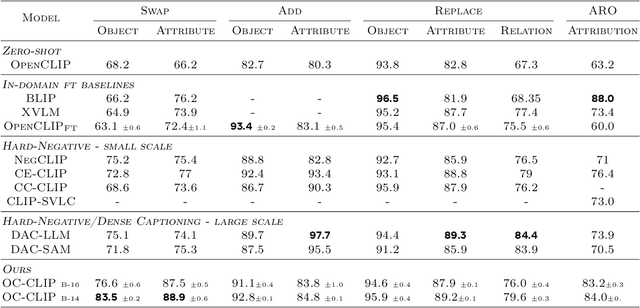

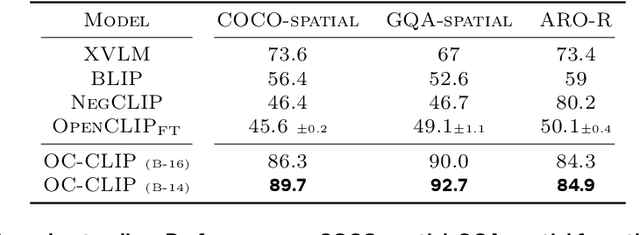
Abstract:Recent advances in vision language models (VLM) have been driven by contrastive models such as CLIP, which learn to associate visual information with their corresponding text descriptions. However, these models have limitations in understanding complex compositional scenes involving multiple objects and their spatial relationships. To address these challenges, we propose a novel approach that diverges from commonly used strategies, which rely on the design of hard-negative augmentations. Instead, our work focuses on integrating inductive biases into pre-trained CLIP-like models to improve their compositional understanding without using any additional hard-negatives. To that end, we introduce a binding module that connects a scene graph, derived from a text description, with a slot-structured image representation, facilitating a structured similarity assessment between the two modalities. We also leverage relationships as text-conditioned visual constraints, thereby capturing the intricate interactions between objects and their contextual relationships more effectively. Our resulting model not only enhances the performance of CLIP-based models in multi-object compositional understanding but also paves the way towards more accurate and sample-efficient image-text matching of complex scenes.
LongVU: Spatiotemporal Adaptive Compression for Long Video-Language Understanding
Oct 22, 2024



Abstract:Multimodal Large Language Models (MLLMs) have shown promising progress in understanding and analyzing video content. However, processing long videos remains a significant challenge constrained by LLM's context size. To address this limitation, we propose LongVU, a spatiotemporal adaptive compression mechanism thats reduces the number of video tokens while preserving visual details of long videos. Our idea is based on leveraging cross-modal query and inter-frame dependencies to adaptively reduce temporal and spatial redundancy in videos. Specifically, we leverage DINOv2 features to remove redundant frames that exhibit high similarity. Then we utilize text-guided cross-modal query for selective frame feature reduction. Further, we perform spatial token reduction across frames based on their temporal dependencies. Our adaptive compression strategy effectively processes a large number of frames with little visual information loss within given context length. Our LongVU consistently surpass existing methods across a variety of video understanding benchmarks, especially on hour-long video understanding tasks such as VideoMME and MLVU. Given a light-weight LLM, our LongVU also scales effectively into a smaller size with state-of-the-art video understanding performance.
An Introduction to Vision-Language Modeling
May 27, 2024


Abstract:Following the recent popularity of Large Language Models (LLMs), several attempts have been made to extend them to the visual domain. From having a visual assistant that could guide us through unfamiliar environments to generative models that produce images using only a high-level text description, the vision-language model (VLM) applications will significantly impact our relationship with technology. However, there are many challenges that need to be addressed to improve the reliability of those models. While language is discrete, vision evolves in a much higher dimensional space in which concepts cannot always be easily discretized. To better understand the mechanics behind mapping vision to language, we present this introduction to VLMs which we hope will help anyone who would like to enter the field. First, we introduce what VLMs are, how they work, and how to train them. Then, we present and discuss approaches to evaluate VLMs. Although this work primarily focuses on mapping images to language, we also discuss extending VLMs to videos.
A Picture is Worth More Than 77 Text Tokens: Evaluating CLIP-Style Models on Dense Captions
Dec 14, 2023



Abstract:Curation methods for massive vision-language datasets trade off between dataset size and quality. However, even the highest quality of available curated captions are far too short to capture the rich visual detail in an image. To show the value of dense and highly-aligned image-text pairs, we collect the Densely Captioned Images (DCI) dataset, containing 8012 natural images human-annotated with mask-aligned descriptions averaging above 1000 words each. With precise and reliable captions associated with specific parts of an image, we can evaluate vision-language models' (VLMs) understanding of image content with a novel task that matches each caption with its corresponding subcrop. As current models are often limited to 77 text tokens, we also introduce a summarized version (sDCI) in which each caption length is limited. We show that modern techniques that make progress on standard benchmarks do not correspond with significant improvement on our sDCI based benchmark. Lastly, we finetune CLIP using sDCI and show significant improvements over the baseline despite a small training set. By releasing the first human annotated dense image captioning dataset, we hope to enable the development of new benchmarks or fine-tuning recipes for the next generation of VLMs to come.
Feedback-guided Data Synthesis for Imbalanced Classification
Sep 29, 2023Abstract:Current status quo in machine learning is to use static datasets of real images for training, which often come from long-tailed distributions. With the recent advances in generative models, researchers have started augmenting these static datasets with synthetic data, reporting moderate performance improvements on classification tasks. We hypothesize that these performance gains are limited by the lack of feedback from the classifier to the generative model, which would promote the usefulness of the generated samples to improve the classifier's performance. In this work, we introduce a framework for augmenting static datasets with useful synthetic samples, which leverages one-shot feedback from the classifier to drive the sampling of the generative model. In order for the framework to be effective, we find that the samples must be close to the support of the real data of the task at hand, and be sufficiently diverse. We validate three feedback criteria on a long-tailed dataset (ImageNet-LT) as well as a group-imbalanced dataset (NICO++). On ImageNet-LT, we achieve state-of-the-art results, with over 4 percent improvement on underrepresented classes while being twice efficient in terms of the number of generated synthetic samples. NICO++ also enjoys marked boosts of over 5 percent in worst group accuracy. With these results, our framework paves the path towards effectively leveraging state-of-the-art text-to-image models as data sources that can be queried to improve downstream applications.
PUG: Photorealistic and Semantically Controllable Synthetic Data for Representation Learning
Aug 08, 2023



Abstract:Synthetic image datasets offer unmatched advantages for designing and evaluating deep neural networks: they make it possible to (i) render as many data samples as needed, (ii) precisely control each scene and yield granular ground truth labels (and captions), (iii) precisely control distribution shifts between training and testing to isolate variables of interest for sound experimentation. Despite such promise, the use of synthetic image data is still limited -- and often played down -- mainly due to their lack of realism. Most works therefore rely on datasets of real images, which have often been scraped from public images on the internet, and may have issues with regards to privacy, bias, and copyright, while offering little control over how objects precisely appear. In this work, we present a path to democratize the use of photorealistic synthetic data: we develop a new generation of interactive environments for representation learning research, that offer both controllability and realism. We use the Unreal Engine, a powerful game engine well known in the entertainment industry, to produce PUG (Photorealistic Unreal Graphics) environments and datasets for representation learning. In this paper, we demonstrate the potential of PUG to enable more rigorous evaluations of vision models.
Predicting masked tokens in stochastic locations improves masked image modeling
Jul 31, 2023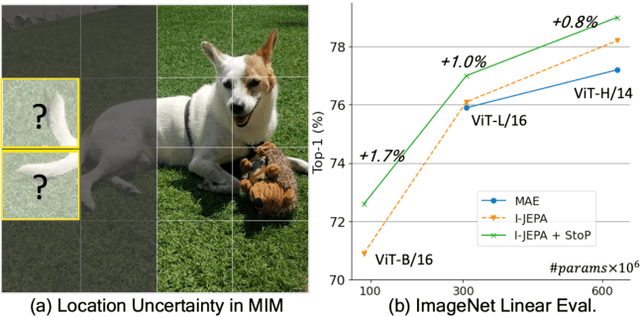
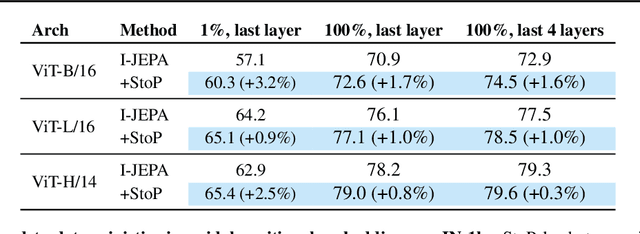
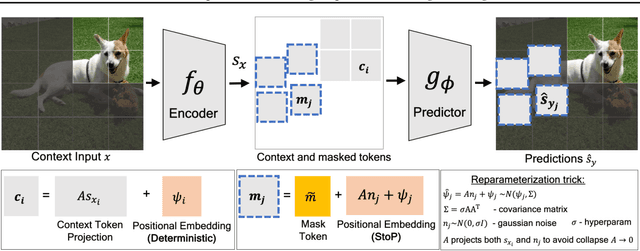
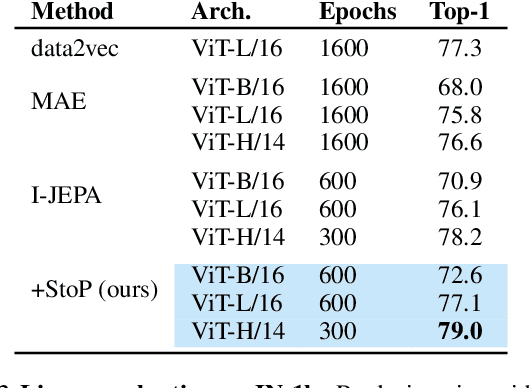
Abstract:Self-supervised learning is a promising paradigm in deep learning that enables learning from unlabeled data by constructing pretext tasks that require learning useful representations. In natural language processing, the dominant pretext task has been masked language modeling (MLM), while in computer vision there exists an equivalent called Masked Image Modeling (MIM). However, MIM is challenging because it requires predicting semantic content in accurate locations. E.g, given an incomplete picture of a dog, we can guess that there is a tail, but we cannot determine its exact location. In this work, we propose FlexPredict, a stochastic model that addresses this challenge by incorporating location uncertainty into the model. Specifically, we condition the model on stochastic masked token positions to guide the model toward learning features that are more robust to location uncertainties. Our approach improves downstream performance on a range of tasks, e.g, compared to MIM baselines, FlexPredict boosts ImageNet linear probing by 1.6% with ViT-B and by 2.5% for semi-supervised video segmentation using ViT-L.
 Add to Chrome
Add to Chrome Add to Firefox
Add to Firefox Add to Edge
Add to Edge